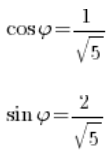
There are days when nothing seems to work.
And there are examples with complex numbers where nothing goes right. The known and memorized methods don’t help.
Take, for instance, this innocent-looking exponentiation:
{( 1+2i )^8}Following the well-trodden path you’ve used in many examples, you want to write the number ![]() in trigonometric form and then raise it to the eighth power using the appropriate formula.
in trigonometric form and then raise it to the eighth power using the appropriate formula.
So you calculate the modulus:

Then you calculate the sine and cosine of the principal argument:

The signs for the cosine and sine are positive, so the angle is in the first quadrant, but your luck ends there.
Unfortunately, the values of the sine and cosine: ![]() and
and ![]() cannot be found in the table of basic trigonometric values. No wonder – the angle
cannot be found in the table of basic trigonometric values. No wonder – the angle ![]() is neither 0, 30, 45, 60, nor 90 degrees.
is neither 0, 30, 45, 60, nor 90 degrees.
So we have a PROBLEM.
What can be done?
Situations where a number raised to a power can’t be easily converted to trigonometric form can happen. Unfortunately.
But no one said that the same number raised to the SQUARE (for example) will still be “unconvertible”.
So try this:

Instead of converting the number: ![]() to trigonometric form, you convert the number
to trigonometric form, you convert the number ![]() …
…
Unfortunately, with equally poor results, because although the modulus is nice and round, the sine and cosine values are still not readable from the table.
What now?
Repeat the maneuver 🙂

And here, instead of struggling with the trigonometric form, simply square it in the algebraic form:

In this way, notice, without really touching the trigonometric form (because we couldn’t), we have calculated a relatively high power of the complex number quite – I think still painlessly -:

Of course. This doesn’t always “work”. But it can help sometimes, right? 🙂


